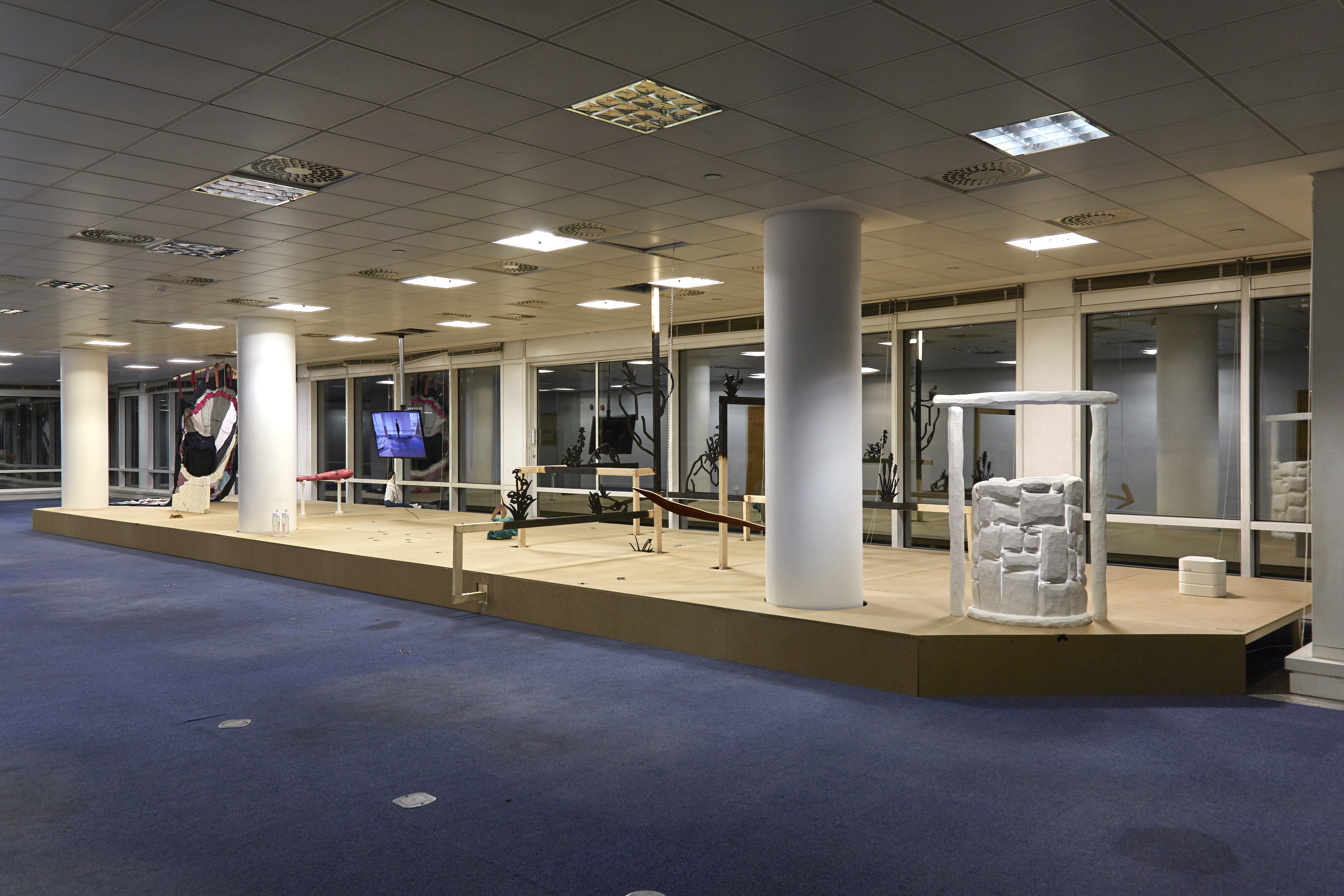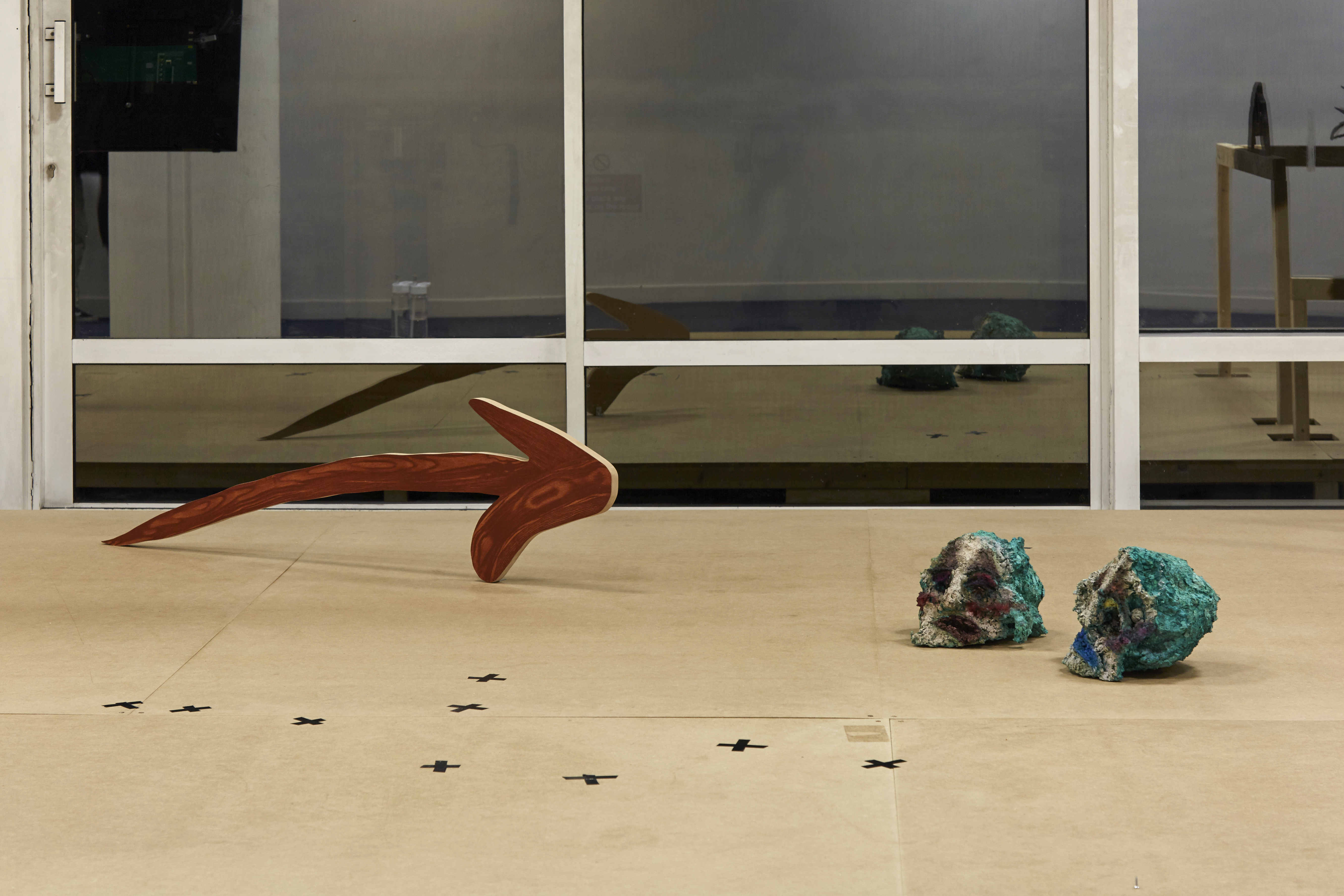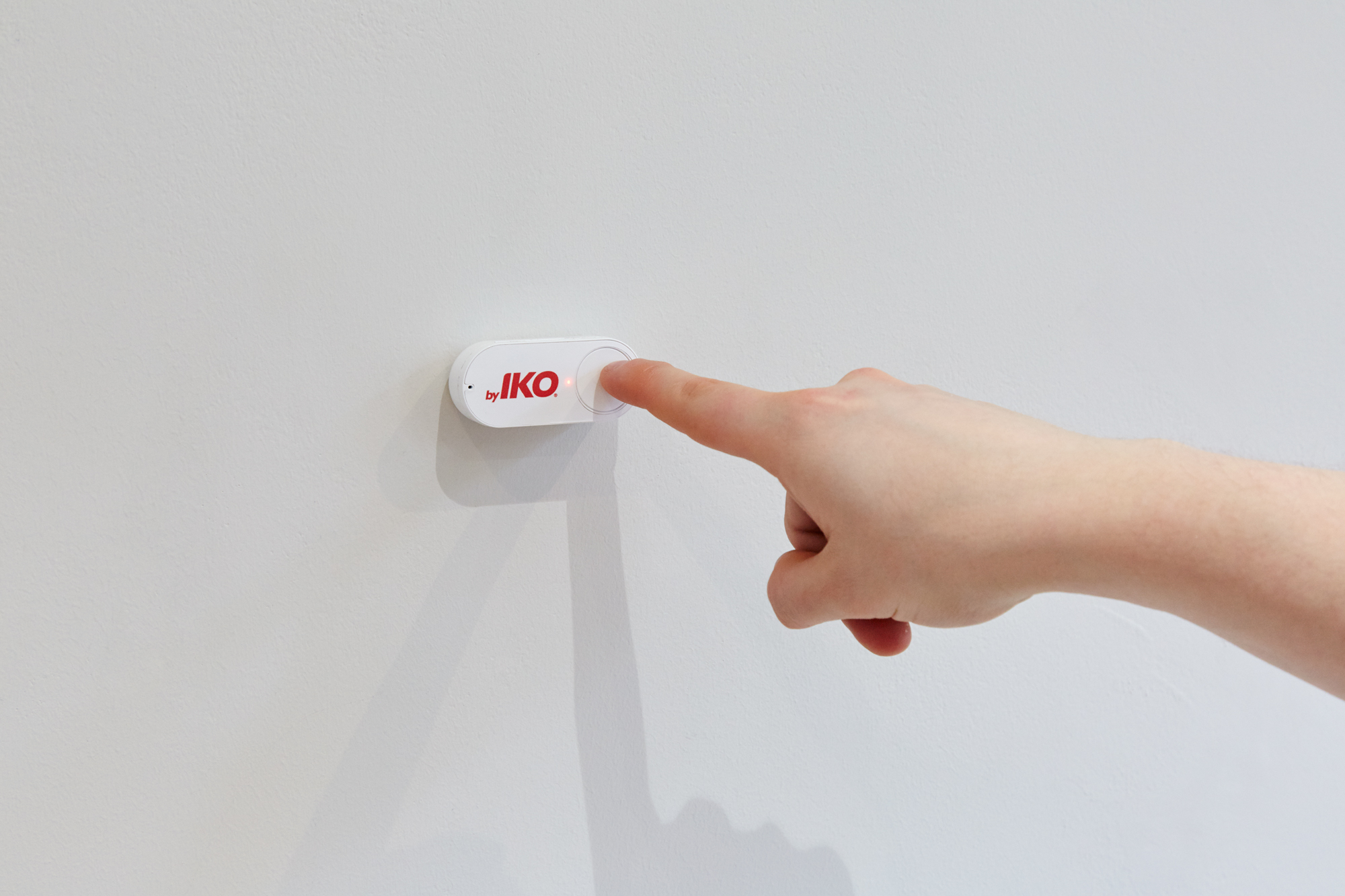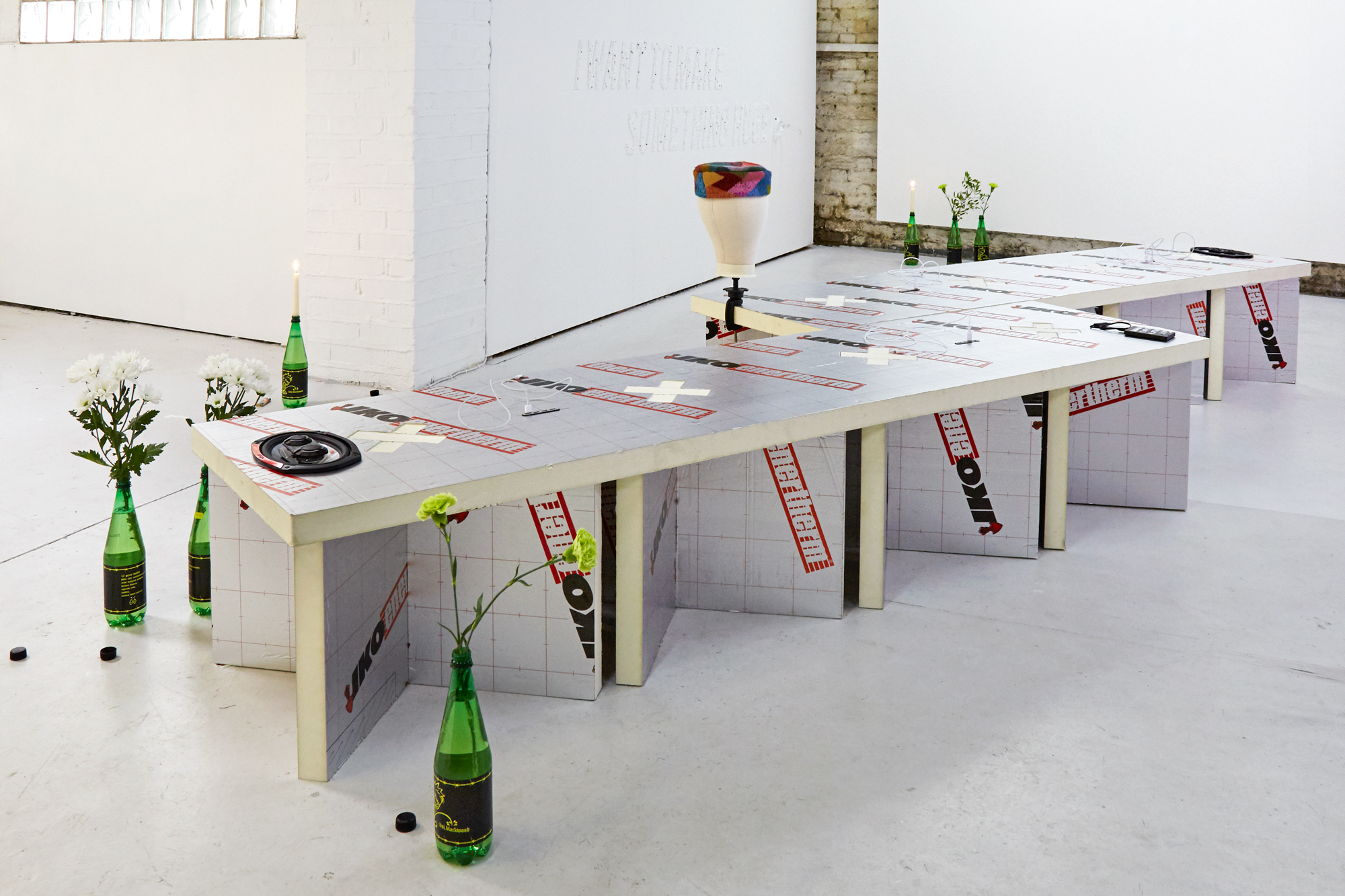IT’S KIND OF HARD TO EXPLAIN (IKO)
Interview by David McLeavy
-
Published September 2018
-
IKO is an artist and curatorial collective based in London that has been operating since 2017. They collaborate with and commission early career artists and writers in the UK on curated group exhibitions, online projects and printed media content. Interested in the language of branding, IKO explores frictions between being an art collective and a commercial entity such as their IKO branded Amazon Dash button.
IKO is driven by allowing and encouraging new structures in consuming and framing art and ideas. They often tailor their projects with unconventional spaces such as ‘SET Capstan House’ (a 7th-floor office block) and ‘Subsidiary Projects’ (a living room in Vauxhall). Their projects reject the showroom model of presenting pre-made artwork in white rooms and work closely with project participants to collaborate and build projects in line with a collective goal.
In addition to their projects, IKO asks early career writers to create a ‘Deep Dive’ in response to their physical exhibitions. ‘Deep Dive’ is a text focused on creative ways of understanding and unravelling the ideas in IKO projects and extends beyond the press release or review.
-

ULTRA SUNRISE, collaboration with MILK, SET, Alscot Road, 2017
Firstly could you describe What IKO is and how it came about?
Hi Dave. Sure, IKO is a curatorial collective formed of three artists - Corey Bartle-Sanderson, Oliver Durcan and Steven Gee. Beginning in early 2017, we put on a show titled ‘Blue Sky Thinking’ at SET('s) former space, Capstan House with Ellie Pearch and Caspar Welch who were also part of the collective at the time. Oly, Ellie and Caspar had just finished the alternative education course ‘Into the Wild’ which is run by Louise Ashcroft (a hero) at Chisenhale Arts Place where a real DIY attitude was drilled into the group. We didn’t want to wait for someone to offer us a show as we had many ideas buzzing between us and a generous offering from SET to use their project space whilst we had a studio there. The mentors on 'Into the Wild' told us their success stories which - bar a couple - all began from self-initiated projects. Oly and Steven studied their Fine Art BA together at UEL back in 2013 and got back in contact as the course was in full swing. Following on, Steven shared us Corey’s website and we invited him over for a meeting. Following the inaugural show and the positive feedback from peers, we just kept going.. naturally becoming project organisers as well as artists with substantial support to get us started from Josh and Roland at SET - who are a rare kind that genuinely put most of their efforts into helping those around them.
The name IKO is the product of a lot of Whatsapp conversations and meetings. After a couple of weeks with no name, someone asked Oly what he said to his family when they asked him to describe his work; viola - ‘It’s Kind Of Hard To Explain’.. which is a phrase we all use too often due to each of our expansive practices. However although people thought it was relatable and quirky, it was almost always a difficult, confusing conversation when telling people that it was our name. 'IKO' was a much more practical abbreviation of it, and opens doors for explanations - 'It's Kind Of' this, 'It's Kind Of' that.

THE WORST SEATS IN THE HOUSE, SET, Capstan House, 2017
What do you think have been the main benefits of working within a group/collective and self initiating projects?
How decisions are made and how ideas move forward behind the name of IKO are much broader and riskier in comparison to how we approach our individual practices. There’s less to lose when there are three of you taking a potential hit on a bad show haha. For example, when we were building a 20-metre stage for ‘The Worst Seats in the House’, which was only four months into being a collective, the classic anxiety of ‘shit, what if this huge stage turns out really bad.. and the whole show turns out really bad..’ come up for us all but was relieved a lot by sharing ownership of the exhibition. About one year later, we have a lot more faith and understanding of each others’ approaches and trust in our projects. We are pushing in a direction that is less tied to conventional models of showing or making art which usually have some sort of safe, historical framework to reference and increasingly, use each other as a framework to reference.
We’ve also found that, because we can’t agree on every decision on how we produce our projects, some decisions (i.e. exhibition layouts, poster design, choosing artists) have to be made even without all three of us liking that decision. For instance, with the ‘Dreamworks’ poster we must have come up with 16 variations of different designs before getting to a final design - and that was just for the poster! Forcefully testing, processing and giving things a chance that we would usually discard on our own has been so beneficial - mainly because we’ve all surprised ourselves liking things we may have previously disliked.

The Ghost of Corey’s Past, 2017
You mentioned the show you produced titled ‘The Worst Seats in the House’. Could you tell me about how this came together and what your ideas were behind the show? Also, I was wondering if this show was also an effort to reach out to artists as a way of building a network for yourselves in some way?
Yeah that show was actually supposed to be a collaboration with another northern collective but due to slow communication, we decided to do something ourselves from scratch about one month before the opening. From an operational point of view, it was incredibly adrenaline fuelled (haha) and the whole project became a bit of a melting pot, receiving varying reactions and starting to explore viewership as a subject. We chose near to all of the artists through Instagram which is very different to how we operate now a year later.. you could say that was a learning curve for us. With a goal for giving our network in London a way to see early career art from around the UK, we wanted to show a top line up of Midlands/Northern artists like Liam Fallon, Alfie Strong, Joe Fletcher Orr, Harry Medley and Lily Ackroyd-Willoughby who mainly or only exhibited outside of London prior to the show. We wanted to show and address a small pool from a Great Lake of object based artists. There was a lot of excitement about the show, the artists and location. Visitors would have to sign into a marble reception and take a glass lift to the 7th floor of a corporate block to get in .. and this was located in East India which is very much a ghost town of East London overlooking Canary Wharf - it was additions such as the location that was all quite bizarre for everyone and got people talking.
Worst Seats was formed of a 15 meter long stage on one half of SET Capstan House (SET run studios, a bar and project spaces in London) which housed work by 8 artists. Being restricted from exploring the work (as you couldn’t walk on the stage) and seeing it from a set distance was intended and our main curatorial goal.. and in direct response to online or secondary experiences of exhibitions; picture documentation often offering a similarly set, restricted view of artwork and by far the most common way art is engaged with currently. This particular idea of restricted viewing was framed within a collaborative piece we made titled‘ The Ghost of Corey’s Past’, consisting of black tape ‘X’s which were marked at every point on the floor and stage where the show was photographed (by Corey - he does all our exhibition photography). Thinking about how the show lives on once it’s finished, or essentially once it’s died, the experience of the physical show crossed over into the ‘after’ experience of many object heavy exhibitions.
We did expand our network with the line up as we were still defining our position of showing artists from around the UK in ‘heavily curated’ (quoted description from Helena Kate Whittingham xx) projects. We wanted artists from out of London to engage with the projects - and lots of people traveled from far to see the show which was great and appreciated highly. It’s the same way we build a network with our other projects as we work with new artists each time. To see an artist run group, show lots of artists from beyond their local area turned some heads but primarily it was a community and curatorial initiative - not a networking one.

byIKO (Amazon Dash Button), Subsidary Projects, 2018
I want to carry on investigating the point you made about the presentation method for ‘The Worst Seats in the House’ being intentionally structured to offer a similar viewing experience to that of Instagram or other online portals. By doing this are you intending to be critical or celebratory of the process of viewing artwork in that way? Or perhaps it is more nuanced than that...?
Primarily, we don’t want to hand viewing instructions and opinions on a plate to audiences, so we wouldn’t say the installation was critical or celebratory of online viewing. Presenting the work in this restricted way, breaking down and removing the conventional access points and partly mirroring viewing experiences from screen based platforms worked as a foundation for how we wanted that show and work to be experienced. It was an entry point for visitors to question what’s important to them when they attend and experience an exhibition. If something was missing by not being able to see the work close up, then maybe the physical format in TWSITH was problematic. If the work was very conceptual and asked more to be ‘known' than to be ‘seen’, then maybe the physical format in TWSITH didn’t matter. These were questions that visitors can answer themselves, reflect on, be critical of if they want to and think about what they care about when they experience work. The point of what we do and how we approach curation as artists is to allow these thoughts to be had.
In answer to whether we are critical of online viewing.. we really don’t have a yes or no answer to it… but in our more recent shows we are interested in people experiencing a physical space in our exhibition.

byIKO, Subsidary Projects, 2018
How do you approach the balance of not giving an audience a didactic reading of the work in a show whilst allowing some point of access to the work? Is this something that you consider when thinking about any accompanying text or what exists online for the shows/projects?
This is definitely case by case - remember TWSITH was one of our first shows and we have refined themes about viewership in our shows since then. Our recent shows like ‘by IKO’, ‘Dreamworks’ and ‘HTTPS://’ were actually a lot more didactic in terms of the introductory material we provided visitors. Press releases and texts for these shows gave a structure to approach the work which was important as our curatorial output has become more refined in their themes. For example 'byIKO’ was emulating a domestic showroom where IKO became a consumer brand and we wanted people to understand the work through the setting (Subsidiary Projects - a living room turned gallery in Vauxhall, London) and through the devices we used in the room (a custom made IKO Amazon Dash button). Explanations for this felt more appropriate as we were asking people to take their gallery showroom hat off and question the function and status of the art objects we make when they were experienced in a legitimate, lived in home and via an Amazon marketplace.
So where we give entry points and definitions of the curatorial direction, we try to avoid formal descriptions of the room that may be more familiar in commercial art spaces - an interpretative experience for visitors to IKO shows is important for us. For our exhibition ‘Dreamworks’, we produced a short book that contained extra material by each artist that reinforced the work and commissioned a foreword by Tom Groves (available to download on our website under ‘Dreamworks’).
Finally, for every project, we ask an artist or writer to produce a ‘Deep Dive’. This is additional interpretive material where we ask for a creative response of each project in the form of a text, or in the case of Dreamworks, a series of audio clips (see Meg Brain’s Deep Dive on our website) that takes the form of a PDF to allow interpretations of our exhibitions to live on after its finished (we release the Deep Dive once the project has finished). We think its important for people to meander and wonder through the ideas that are experienced in any exhibition and the motivations behind the Deep Dive’s promote that.

DREAMWORKS (books), Limbo, Margate, 2018
You are also supporting the work of a large number of emerging artists through your projects and also through your social media marketing ahead of your shows, for example you post images of each artists work who will be participating within an exhibition. This approach strikes me as a combination of becoming advocates for particular artist’s work whilst also being very useful in spreading the word about what you are putting together. Do consider this an accurate assessment?
Social media is a massive part of what we do - especially when we are doing funded projects like Dreamworks which was supported with Arts Council England National Lottery Grants, Hexio and Pabst Brewing Company. As well as being commissioned to make artwork, participants also got a funded social media campaign and online press coverage. We’ve got to make sure the project is getting a decent coverage for ours and the artists growth but also to meet the expectations of those funding us - so a lot of effort went into that project online too.
The marketing conversations between us and the show participants usually starts by us asking if they want to send specific images to be posted or whether we can find work we like online. It means that our followers that would usually visit our shows can gradually develop an understanding of a featured artists work, do some extra research beyond our socials if they’d like to and come to the show with some understanding of how the exhibited work carries on from their previous practices.
Yep Dave - your assessment is spot on ;)

HTTPS://, Sluice, London, 2018
-
IKO is run by Oliver Durcan, Corey Bartle-Sanderson and Steven Gee
-
itskindof.com
-
If you like this why not read our interview with Colette Griffin
-
© 2013 - 2018 YAC | Young Artists in Conversation ALL RIGHTS RESERVED
